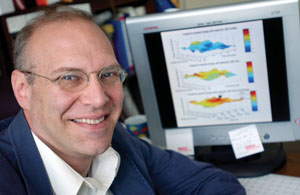
Ronald Salomon, M.D., has produced a more complete view of brain chemicals and how their shifting levels relate to depression.
photo by Dana Johnson
Study finds brain chemical cycles get ‘stuck’ in depression
Scientists have studied serotonin and dopamine and their roles in depression for decades, taking snapshots of the chemicals as they ebbed and flowed. But the pictures never completely told the entire story; they never showed changes in the chemicals' levels.
Ronald Salomon, M.D., associate professor of Psychiatry, literally tapped into people with depression. By gathering spinal fluid via catheters every 10 minutes over a 24-hour period, he revealed a more complete view of the waves of brain chemicals that push and pull the disease. The fluids were collected during a depressive episode and again after five weeks of antidepressant medication, and showed that brain chemical levels don't rise and fall normally in the disease — they're “stuck.”
Dopamine, generally, activates instinctual behaviors, is involved in cravings, addictions and reward systems and has a role in independent, goal-oriented behaviors. Serotonin fuels calm, sedate moods, decreases impulsive behaviors and assists with socializing. Dopamine and serotonin typically flow and fluctuate independently, balancing each other over time.
But Salomon found that in people with untreated depression the two chemicals often flow together with less variability than normal, and fail to respond independently. This lack of chemical variability, he says, may explain why people with depression get "stuck" in extremes of moods or behaviors — sleeping too much or not enough, eating ravenously or poorly, ruminating continuously or going blank for long periods. The findings were published in the journals Neuropsychopharmacology and Disease Markers.
Most physicians think of the chemicals controlling depression and moods as a constant current accessible with the flick of a switch, Salomon says. "It's as if a steady chemical supply is there, and if (someone) decides to use that energy there's some volitional decision to say, 'OK, I'm going to Baskin-Robbins for ice cream, even if my brain chemistry wants me to nap.'
"The answer is 'no.' If the person feels like taking a nap, the chemistry won't be easily ignored. That feeling is not just a matter of volition, it's a matter of chemistry," Salomon said. The same is true of the sadness and other symptoms of depression.
Healthy people have feelings that change rapidly, over just a few minutes, because the chemical levels change all the time. So, bad feelings quickly give way to normal feelings. But people with depression don't cycle normally. "If they're not feeling the energy now, they're not going to feel the energy in 10 minutes or in an hour or even in three hours. They're going to feel stuck."
The “data movie” created might explain why medicines seem to lose benefit in long-term therapy and why some people feel better temporarily after stopping medicines on their own, something that Salomon does not recommend. But such anecdotes are fairly common, he said, "and we've always kind of ignored those reports of temporary improvement.
"We aim for constant blood levels — to give a consistent effect throughout the day, which gets the oscillations started and helps shift the chemistry out of the 'stuckness.' But after a while the system feedback gets used to the drugs and the oscillations slow down again. So stopping the drug suddenly after a few years might essentially kick the system and start it oscillating again. That might work for a couple of months, and then the oscillations stop and the symptoms come back and they're depressed again."
The problem, Salomon said, is that sometimes sudden changes can make things worse instead of better, so careful and supervised changes are best. Starting a new medication restarts the oscillations, and the depression gets better.
This also explains why drugs don't work right away. "We know that the first dose of these medicines is at the receptors within hours, but they're not improving the depression for a couple of weeks. What may be needed is for the system to start to oscillate again. (The study's finding) is an oscillatory model that explains a lot of things that have really been thorns in our theory," Salomon said. Understanding these oscillations might help treat depression better and without lost responses.
The oscillation viewpoint also suggests that when talk therapists recognize those “stuck” periods of sadness, their therapeutic suggestions for changes in a patient's routine can steer them out of a rut.
Salomon is currently working on a replication study.













